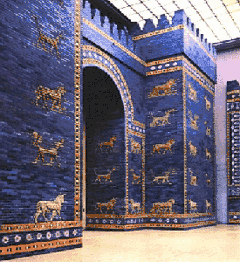Elamite dynasty
The Elamite dynasty, also known as the seventh Babylonian dynasty, was a short-lived dynasty of Elamite origin who ruled from the city of Babylon in the early 10th century BC. The dynasty's first and only ruler was Mar-biti-apla-usur.
Elamite Dynasty | |
|---|---|
| c. 980 BC — c. 975 BC | |
Mar-biti-apla-usur's name in Akkadian cuneiform in the Dynastic Chronicle | |
| Capital | Babylon |
| Common languages | Akkadian language |
| Government | Monarchy |
| King | |
• c. 980 BC | Mar-biti-apla-usur (first and last) |
| Historical era | Ancient History |
• Established | c. 980 BC |
• Disestablished | c. 975 BC |
| Today part of | Iraq |
History

Babylon's seventh dynasty, also known as the Elamite dynasty, was founded around 980 BC.[3][4] It was the third of a series of very short lived Babylonian dynasties, namely the Second Sealand Dynasty, the Bazi Dynasty and the Elamite Dynasty.[4][5] Its first and sole ruler was the Elamite Mar-biti-apla-usur.[6][7] His regnal name was Akkadian, which was the language spoken in Babylon at the time. However, since no known rulers of Elam are known to have carried Akkadian titles (though Mār-bīti-apla-uṣur was his Babylonian name, and his reign coincides with a blank period in Elamite political history), Brinkman has argued that he might not have been himself from Elam, nor the patrilineal descendant of an Elamite, but rather a Babylonian with some Elamite ancestor (possibly a king).[8]
Fall of the Dynasty
The dynasty's reign might have suffered Aramean incursions, because of which the Akitu festival might have been suspended.[i 1][9] After his death, the dynasty's sole ruler Mar-biti-apla-usur was buried in the palace of Sargon as a “legitimate king.” This designation depends on the interpretation of ina É-GAL LUGAL(-)GI.NA qé.bir, suggesting an interment suitable for a rightful king.[10]
List of kings of the Elamite Dynasty
| Name | Reign | Succession and notes | Ref |
| Mar-biti-apla-usur Mār-bīti-apla-uṣur |
c. 980 – 975 BC (6 years) |
First and last member of the dynasty | [11] |
Notes
- Eclectic Chronicle (ABC 24) tablet BM 27859 line 16.
References
- Potts, D. T. (April 2006). "Elamites and Kassites in the Persian Gulf". Journal of Near Eastern Studies. University of Chicago Press. 65 (2): 111–119. doi:10.1086/504986. S2CID 162371671.
- Lion, Brigitte; Michel, Cécile (2016). The Role of Women in Work and Society in the Ancient Near East. De Gruyter. p. 419. ISBN 9781614519089.
- Berman, Stephen (2005). Handbook to Life in Ancient Mesopotamia. OUP USA. p. 92. ISBN 9780195183641.
Mar-biti-apla-usur (ca. 975 B.C.E) Marbiti-apla-usur was the founder and, to his regret, sole member of Babylon's Seventh Dynasty, also known as the Elamite dynasty
- McConville, G.; Boda, Mark J. (2020). Dictionary of the Old Testament: Prophets A Compendium Of Contemporary Biblical Scholarship. IVP. ISBN 9781789740387.
Babylonia was ruled by a succession of three brief and undistinguished dynasties: the Second Sealand Dynasty, the Bazi Dynasty and the Elamite Dynasty, taking us to approximately 980 BC (Arnold 2004, 79-81).
- Saggs, H.W.F. (2000). Babylonians. University of California Press. p. 131. ISBN 9780520202221.
- Brinkman, J. A. (1968). Political history of Post-Kassite Babylonia (1158-722 b. C.) (A). Gregorian Biblical BookShop. p. 317.
With the exception of Mar - biti - apla - usur, a Babylonian king of Elamite descent in the early tenth century, nothing more is heard of Elam until it sent troops to assist against the Assyrians at the battle near Dur
- Basmachi, Faraj (1976). Treasures of the Iraq Museum. Ministry of Information. p. 83.
Elamite Dynasty ( Seventh Dynasty of Babylon ) This consisted of only the single reign of Mar - biti - apla - usur
- Chen, Fei (2020). Study on the Synchronistic King List from Ashur. Brill. p. 86. ISBN 9789004430921.
Mar-biti-apla-usur is the only king whose reign of 6 years consistuted an ephemeral dynasty, which is usually called the Elamite Dynasty. This might be due to the fact that the Dynastic Chronicle stated that he was a descendant of a certain Elamite. However, the truth might be that he was just "a Babylonian who could claim an Elamite (and possibly an Elamite king) among his ancestors".
- J. A. Brinkman (1982). "Babylonia, c. 1000 – 748 B.C.". In John Boardman; I. E. S. Edwards; N. G. L. Hammond; E. Sollberger (eds.). The Cambridge Ancient History (Volume 3, Part 1). Cambridge University Press. p. 297.
- J. A. Brinkman (1968). A Political History of Post-Kassite Babylonia 1158-722 B.C. (AnOr 43). Pontifium Institutum Biblicum. pp. 155, 165–166.
- Beaulieu, Paul-Alain (2018). A History of Babylon, 2200 BC - AD 75. Wiley. p. 176. ISBN 9781405188999.

